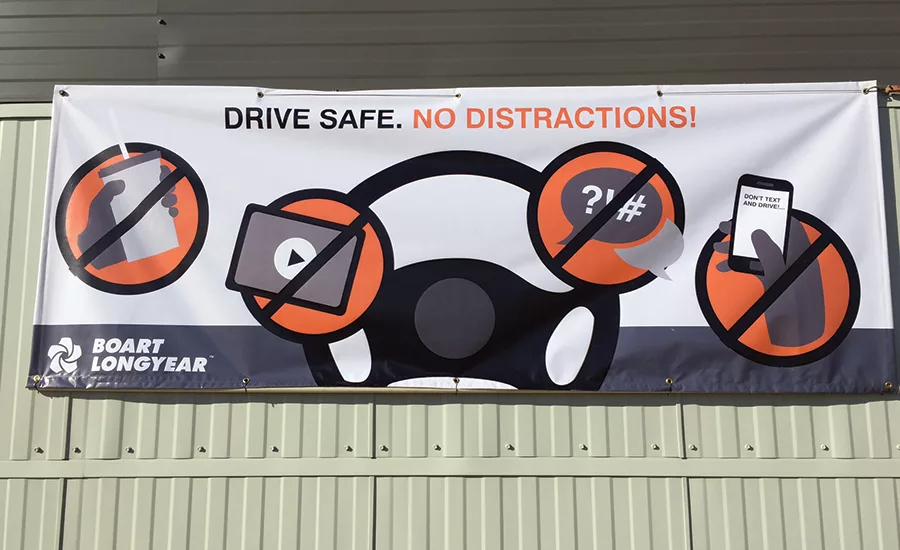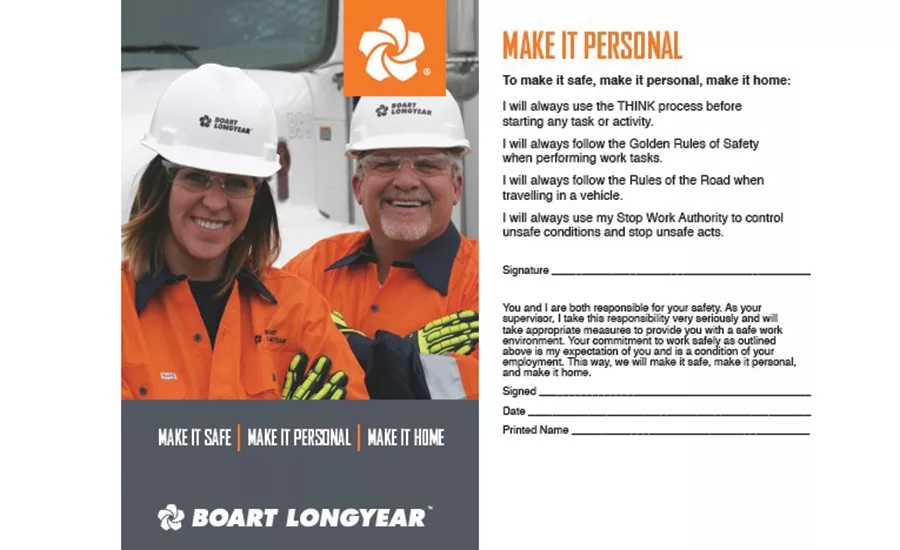Drilling Contractors Reduce Risk with Distracted Driving Policies

The company posts banners and other reminders in parking lots, offices and elsewhere to reinforce its behind-the-wheel policy. Source: Boart Longyear photos

For Boart Longyear employees, “DNT TXT N DRV” is merely the beginning. The company’s new Distracted Driving Policy spells things out much more clearly than that.
Safety is a way of life at Boart Longyear, where extensive safety programs, standards and processes are in place to enable employees to maximize their productivity without compromising their wellbeing and health. But driving remains our most serious potential risk, even though we are a drilling and manufacturing company.
We have always taken the hazards of driving very seriously. In-vehicle monitoring systems in hundreds of company vehicles have helped to reduce serious accidents by providing verbal coaching to drivers when called for. In addition, we recently refreshed our Golden Rules of Safety, Rules of the Road and Make It Personal pocket cards to remind employees of our expectations.
But with the ever-increasing sources of distraction for drivers behind the wheel, management and the board of directors want to be even more explicit about the potential risks and repercussions of distracted driving.
The result was our first-ever Distracted Driving Policy, launched companywide in July. And it doesn’t simply prohibit texting and driving.
Under the policy, distracted driving is any activity that could divert a person’s attention away from the primary task of driving. That is because distracted driving reduces awareness, impairs decision-making ability and performance, and leads to increased risk of driver error, near-misses or incidents.
The policy applies to all employees of Boart Longyear and its subsidiaries, as well as contractors, subcontractors, temporary employees or interns, while operating a vehicle owned, leased or rented by the company, or operating a personal vehicle while traveling on or conducting company business.
Employees have responded very positively to the new mandate because the benefits are obvious. The promise of zero-tolerance enforcement notwithstanding, no violations of the policy have been reported since the rollout.
In short, everyone is aware of the potential hazards. We are all on the same page as to why distracted driving is a threat not only to our business but to people’s way of life.
As the policy lays out right up front, “The purpose of this policy is to protect the health and safety of Boart Longyear employees and eliminate unnecessary risks behind the wheel. Distracted driving also puts others at risk so, in addition to protecting yourself, avoiding distracted driving protects you from harming others.”
The policy specifies only two electronic devices that employees are authorized to use while driving: minesite or operationally mandated two-way radios, and hands-free telephones with voice-activated dialing features for making and receiving calls.
On the other hand, employees may not under any circumstances use electronic devices of any type to perform the following activities while driving:
- Using a handheld phone to make or receive calls
- Adjusting a GPS or other navigational device
- Accessing or searching the Internet
- Sending, reading or preparing emails, instant messages or text messages
- Using or adjusting portable MP3 music devices
Even in cases where a phone or vehicle is capable of preparing or reading electronic messages “hands free,” that activity is strictly prohibited while driving. Employees are also prohibited from using headphones, ear buds or similar products while driving.
The policy also notes that “Sending or receiving a text takes a driver’s eyes from the road for an average of 4.6 seconds, the equivalent — at 55 mph — of driving the length of an entire football field blind.”
And don’t even think about checking a text message while stuck in traffic. Under the policy, “These prohibitions apply whether the vehicle is in motion or is stopped at an intersection or signal.” Those who really need to use their phones or other electronic devices are instructed to pull over safely to the side of the road or another safe location, apply the emergency brake and put the vehicle in park.
Because distracted driving is any activity that could divert attention away from the primary task of driving, the policy reminds employees that they must always “drive to conditions” — taking into account such things as road conditions, traffic, weather and the size and type of vehicle they are driving. They are advised not to perform even seemingly routine tasks — including adjusting a radio, CD player or MP3 player; talking to passengers; eating and drinking; and grooming — if driving conditions would make it unsafe to do so.
An internal team developed online and live training modules to reach employees throughout our company, which operates in over 30 countries. Banners and other reminders in parking lots, offices and minesites, and on the company’s intranet also reinforce the policy.
Our employees drive in all parts of the world under all sorts of conditions — from the ice roads of Baffin Island in northern Canada to the deserts of Mali. Avoiding distractions while driving is just as important on the streets of Salt Lake City or at a minesite in rural Nevada.
Likewise, it’s a good idea off the job, too.
We are not just putting policies in place as a deterrent, but as a company we are striving to connect with our employees. We hope they will “take it home with them” and apply these principles every day.
The recently reissued Make It Personal pocket card helps to reinforce that message. Every employee is asked to sign a card and add a picture of why they stay safe.
It’s not only our concern about our own corporate fleet and the possibility that our drivers may increase that risk if they are distracted while driving. At the end of the day, they need to drive home safely to get back to what’s most important to them.
Looking for a reprint of this article?
From high-res PDFs to custom plaques, order your copy today!





